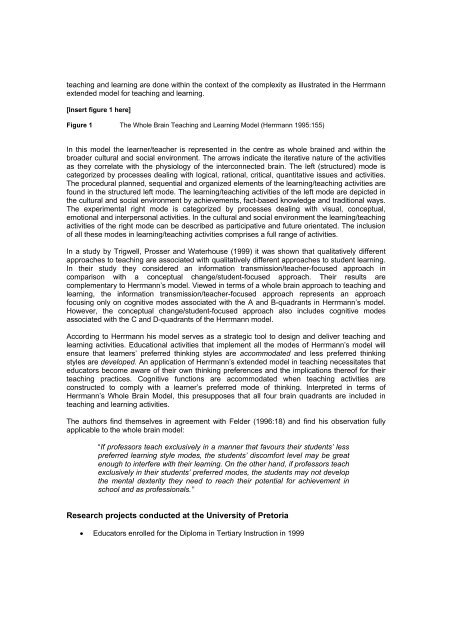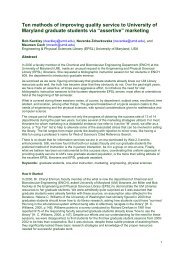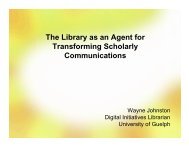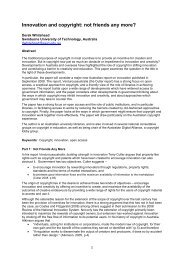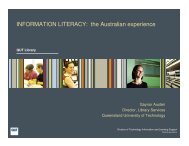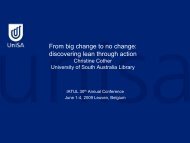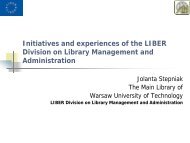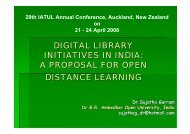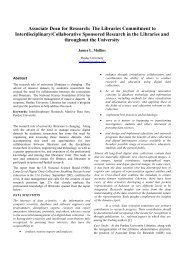Thinking styles and their role in teaching and learning Abstract - IATUL
Thinking styles and their role in teaching and learning Abstract - IATUL
Thinking styles and their role in teaching and learning Abstract - IATUL
You also want an ePaper? Increase the reach of your titles
YUMPU automatically turns print PDFs into web optimized ePapers that Google loves.
teach<strong>in</strong>g <strong>and</strong> learn<strong>in</strong>g are done with<strong>in</strong> the context of the complexity as illustrated <strong>in</strong> the Herrmann<br />
extended model for teach<strong>in</strong>g <strong>and</strong> learn<strong>in</strong>g.<br />
[Insert figure 1 here]<br />
Figure 1 The Whole Bra<strong>in</strong> Teach<strong>in</strong>g <strong>and</strong> Learn<strong>in</strong>g Model (Herrmann 1995:155)<br />
In this model the learner/teacher is represented <strong>in</strong> the centre as whole bra<strong>in</strong>ed <strong>and</strong> with<strong>in</strong> the<br />
broader cultural <strong>and</strong> social environment. The arrows <strong>in</strong>dicate the iterative nature of the activities<br />
as they correlate with the physiology of the <strong>in</strong>terconnected bra<strong>in</strong>. The left (structured) mode is<br />
categorized by processes deal<strong>in</strong>g with logical, rational, critical, quantitative issues <strong>and</strong> activities.<br />
The procedural planned, sequential <strong>and</strong> organized elements of the learn<strong>in</strong>g/teach<strong>in</strong>g activities are<br />
found <strong>in</strong> the structured left mode. The learn<strong>in</strong>g/teach<strong>in</strong>g activities of the left mode are depicted <strong>in</strong><br />
the cultural <strong>and</strong> social environment by achievements, fact-based knowledge <strong>and</strong> traditional ways.<br />
The experimental right mode is categorized by processes deal<strong>in</strong>g with visual, conceptual,<br />
emotional <strong>and</strong> <strong>in</strong>terpersonal activities. In the cultural <strong>and</strong> social environment the learn<strong>in</strong>g/teach<strong>in</strong>g<br />
activities of the right mode can be described as participative <strong>and</strong> future orientated. The <strong>in</strong>clusion<br />
of all these modes <strong>in</strong> learn<strong>in</strong>g/teach<strong>in</strong>g activities comprises a full range of activities.<br />
In a study by Trigwell, Prosser <strong>and</strong> Waterhouse (1999) it was shown that qualitatively different<br />
approaches to teach<strong>in</strong>g are associated with qualitatively different approaches to student learn<strong>in</strong>g.<br />
In <strong>their</strong> study they considered an <strong>in</strong>formation transmission/teacher-focused approach <strong>in</strong><br />
comparison with a conceptual change/student-focused approach. Their results are<br />
complementary to Herrmann’s model. Viewed <strong>in</strong> terms of a whole bra<strong>in</strong> approach to teach<strong>in</strong>g <strong>and</strong><br />
learn<strong>in</strong>g, the <strong>in</strong>formation transmission/teacher-focused approach represents an approach<br />
focus<strong>in</strong>g only on cognitive modes associated with the A <strong>and</strong> B-quadrants <strong>in</strong> Herrmann’s model.<br />
However, the conceptual change/student-focused approach also <strong>in</strong>cludes cognitive modes<br />
associated with the C <strong>and</strong> D-quadrants of the Herrmann model.<br />
Accord<strong>in</strong>g to Herrmann his model serves as a strategic tool to design <strong>and</strong> deliver teach<strong>in</strong>g <strong>and</strong><br />
learn<strong>in</strong>g activities. Educational activities that implement all the modes of Herrmann’s model will<br />
ensure that learners’ preferred th<strong>in</strong>k<strong>in</strong>g <strong>styles</strong> are accommodated <strong>and</strong> less preferred th<strong>in</strong>k<strong>in</strong>g<br />
<strong>styles</strong> are developed. An application of Herrmann’s extended model <strong>in</strong> teach<strong>in</strong>g necessitates that<br />
educators become aware of <strong>their</strong> own th<strong>in</strong>k<strong>in</strong>g preferences <strong>and</strong> the implications thereof for <strong>their</strong><br />
teach<strong>in</strong>g practices. Cognitive functions are accommodated when teach<strong>in</strong>g activities are<br />
constructed to comply with a learner’s preferred mode of th<strong>in</strong>k<strong>in</strong>g. Interpreted <strong>in</strong> terms of<br />
Herrmann’s Whole Bra<strong>in</strong> Model, this presupposes that all four bra<strong>in</strong> quadrants are <strong>in</strong>cluded <strong>in</strong><br />
teach<strong>in</strong>g <strong>and</strong> learn<strong>in</strong>g activities.<br />
The authors f<strong>in</strong>d themselves <strong>in</strong> agreement with Felder (1996:18) <strong>and</strong> f<strong>in</strong>d his observation fully<br />
applicable to the whole bra<strong>in</strong> model:<br />
“If professors teach exclusively <strong>in</strong> a manner that favours <strong>their</strong> students’ less<br />
preferred learn<strong>in</strong>g style modes, the students’ discomfort level may be great<br />
enough to <strong>in</strong>terfere with <strong>their</strong> learn<strong>in</strong>g. On the other h<strong>and</strong>, if professors teach<br />
exclusively <strong>in</strong> <strong>their</strong> students’ preferred modes, the students may not develop<br />
the mental dexterity they need to reach <strong>their</strong> potential for achievement <strong>in</strong><br />
school <strong>and</strong> as professionals.”<br />
Research projects conducted at the University of Pretoria<br />
• Educators enrolled for the Diploma <strong>in</strong> Tertiary Instruction <strong>in</strong> 1999


